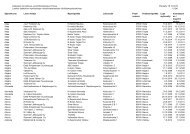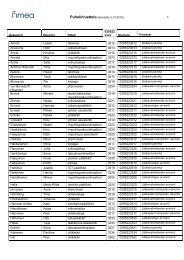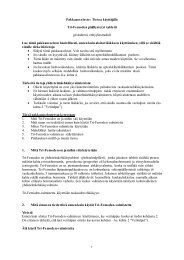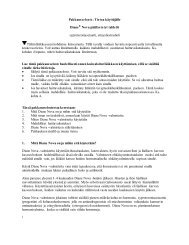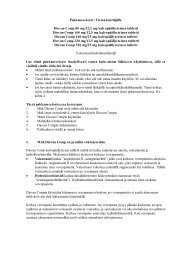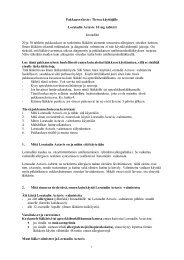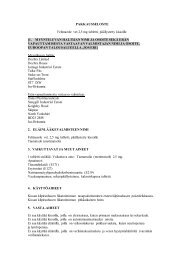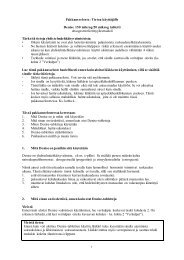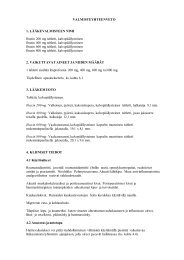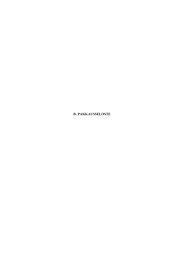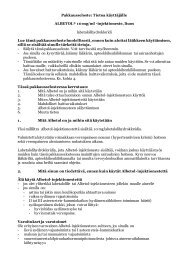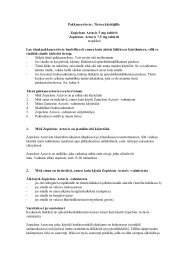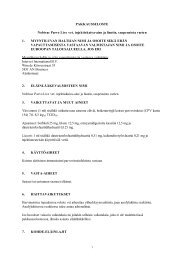Tabu 6.2007 - Fimea
Tabu 6.2007 - Fimea
Tabu 6.2007 - Fimea
You also want an ePaper? Increase the reach of your titles
YUMPU automatically turns print PDFs into web optimized ePapers that Google loves.
6|2007<br />
RAUHALLISTA JOULUA JA ONNELLISTA UUTTA VUOTTA 2008<br />
GOD JUL OCH GOTT NYTT ÅR 2008<br />
SEASON´S GREETINGS AND BEST WISHES FOR THE NEW YEAR 2008
Ledare<br />
Om biverkningar<br />
Läkemedel för djur<br />
Editorial<br />
ADR News<br />
37<br />
38<br />
40<br />
44<br />
47<br />
51<br />
53<br />
54<br />
56<br />
58<br />
61<br />
TABU <strong>6.2007</strong> | 15 årgången | 15th Annual volume<br />
På svenska | Översättning Mats Försskåhl<br />
Fortsatt behov att utveckla de europeiska<br />
förfarandena för försäljningstillstånd<br />
Pekka Kurki<br />
Läkemedelspolitiska utvecklingslinjer<br />
Anna Karjalainen | Anna Koski-Pirilä | Ulla Närhi |<br />
Hannes Wahlroos<br />
God munhälsa ger äldre livskvalitet<br />
Taina Remes-Lyly<br />
Terbinafin – en smaksak<br />
Raimo Suhonen<br />
Lokalanestetika med artikain och känselstörningar<br />
Leo Tjäderhane | Annikka Kalliokoski<br />
Om veterinärmedicinska läkemedels miljörisker<br />
Katariina Kivilahti-Mäntylä<br />
Läs TABU också vid Läkemedelsverkets web-sidor<br />
http://www.nam.fi/svenska/publikationer/tabu/index.html<br />
In English | Translation Mervi Moisander<br />
European marketing authorisation procedures –<br />
scope for further development<br />
Pekka Kurki<br />
Recent developments in pharmaceutical policy<br />
Anna Karjalainen | Anna Koski-Pirilä | Ulla Närhi |<br />
Hannes Wahlroos<br />
Terbinafine – a matter of taste<br />
Raimo Suhonen<br />
Articaine-containing local anaesthetics and<br />
sensory disturbances<br />
Leo Tjäderhane | Annikka Kalliokoski<br />
Further development of the management of marketing<br />
authorisation issues<br />
Pekka Kurki | Irmeli Happonen | Marjo-Riitta Helle |<br />
Pirjo Laitinen-Parkkonen | Risto Salmi<br />
Read TABU also on the web<br />
http://www.nam.fi/english/publications/tabu/index.html
Pekka Kurki<br />
Head of Department, Professor<br />
National Agency for Medicines<br />
In English<br />
European marketing authorisation procedures –<br />
scope for further development<br />
Innovative new medicinal products in the European<br />
Union are assessed according to the centralised<br />
procedure coordinated by the European Medicines<br />
Agency, EMEA. Marketing authorisation applications<br />
for other medicines are mainly managed in<br />
the decentralised and mutual recognition procedures<br />
which are based on the mutual collaboration<br />
of the national agencies. Nowadays the national<br />
marketing authorisation procedure is mainly focused<br />
on the maintenance of old authorisations and<br />
the evaluation of authorisations for generic medicinal<br />
products (future reference member state duties).<br />
Rational sharing of work among the national medicines<br />
agencies is the aim intended by the EU common<br />
procedures. The goal is to avoid overlapping<br />
work, in order to have adequate expert resources<br />
available for execution of new regulatory duties<br />
and to improve the quality of regulation.<br />
Common EU procedures rely on the network of<br />
medicines agencies, with EMEA playing the central<br />
role. The network model has several advantages in<br />
a community like the EU, where the organisation<br />
of healthcare, the traditions of pharmacotherapy<br />
and the disease epidemiology vary from one member<br />
state to another. The future of the network<br />
model is dependent on whether the member states<br />
wish to contribute to the mutual collaboration byoffering<br />
their best expertise for tasks which involve<br />
other member states of the EU.<br />
Marketing authorisation applications and applications<br />
for variations to the authorisations are fast<br />
growing in number. Increased demands on quality<br />
assurance and openness, and arbitration procedures<br />
associated with disputes between member states<br />
make the marketing authorisation processes ever<br />
more complicated. Increasing measures are required<br />
from the regulatory authorities to improve<br />
the availability of medicines, including medicinal<br />
products for children and orphan drugs. The extent<br />
of scientific and general advice for small- and medium-sized<br />
businesses has constantly increased. The<br />
implementation of the regulation of developed therapies<br />
(gene and cell therapy, tissue engineering) will<br />
commence in 2008. This regulation requires the<br />
setting up of a new committee within EMEA and,<br />
for example, the evaluation of medicinal products<br />
while they are still under development.<br />
TABU 6. 2007<br />
Editorial<br />
EU marketing authorisation procedures have<br />
generally worked well. Indications of overloading<br />
of the system have nevertheless started to emerge in<br />
recent years. The problem is also due to causes other<br />
than the increased number of applications and<br />
regulatory responsibilities. The operation of the<br />
medicines regulatory network relies upon the national<br />
medicines agencies to take on tasks on behalf<br />
of other member states. This principle has not been<br />
fully followed, but instead, the mutual responsibilities<br />
are shared by too few medicines agencies.<br />
A lack of resources and expertise at EU level<br />
may hinder a state from operating as a rapporteur<br />
or as a reference member state in the centralised,<br />
decentralised or mutual recognition procedures.<br />
The lack of contributions may also be explained by<br />
the heavy responsibilities involved in the procedures<br />
which the reference or rapporteur state will<br />
have to accept. The heavy assessment process in respect<br />
of the centralised procedure can be justified<br />
by the extent of evaluation, by the innovativeness<br />
of the drugs under evaluation, and by the genuine<br />
intention to listen carefully to the applicant and the<br />
experts. The decentralised and mutual recognition<br />
procedures involve national interests and, at worst,<br />
mutual lack of trust among the authorities. Common<br />
decisions sometimes require harmonisation of<br />
national regulatory principles and even of treatment<br />
practices, while the member states generally<br />
show great reluctance to accept this.<br />
We have a situation at present, where agencies<br />
that are active in reference member state duties<br />
have one after the other been forced to accept that<br />
they are no longer coping with the processing,<br />
within the due period, of the applications for marketing<br />
authorisations submitted to them. NAM has<br />
also been immersed in a severe backlog of applications.<br />
Analysis of the situation is followed by a<br />
conclusion that the operational procedures should<br />
be changed by streamlining, prioritising and automating<br />
the assessment and administration of applications.<br />
A paper in this issue of TABU describes<br />
the status of marketing authorisation procedures<br />
and a strategy for reinstating a marketing authorisation<br />
application procedure which is able to respect<br />
the due dates without jeopardising the safety<br />
of medicines or NAM’s strategic aims.<br />
53
54<br />
Anna Karjalainen<br />
M.A., Research Secretary<br />
National Agency for Medicines<br />
Hannes Wahlroos<br />
Professor, Director General<br />
National Agency for Medicines<br />
In English<br />
Recent developments in pharmaceutical policy<br />
Several reforms have been made<br />
in the Finnish pharmaceutical<br />
service in recent years, focusing<br />
on the management of pharmaceutical<br />
costs in particular. Concern<br />
for the rise in pharmaceutical<br />
costs has increased with the<br />
introduction of expensive new<br />
drugs onto the market and an<br />
ageing population. In the Government<br />
Programme (1) of Prime<br />
Minister Matti Vanhanen’s second<br />
Cabinet, the definitions of<br />
pharmaceutical policy emphasise<br />
cost-effectiveness and restraining<br />
the rising costs but also focus on<br />
safe pharmacotherapy, securing<br />
extensive pharmaceutical service<br />
and introducing a just ceiling system<br />
with regard to client charges<br />
in social and health care services<br />
(1).<br />
Restraints on drug costs<br />
In 2005, pharmaceutical costs<br />
represented 16,3% of the total<br />
healthcare expenditure (2), and<br />
in the first years after 2000, real<br />
annual growth in costs was between<br />
4% and 8%. Pharmaceutical<br />
policy measures taken in recent<br />
years have nevertheless<br />
yielded at least short-term results<br />
in cutting pharmaceutical costs.<br />
In the year 2006, the wholesale<br />
value of outpatient drugs decreased<br />
for the first time for decades.<br />
This resulted from the 5%<br />
cut, implemented at the beginning<br />
of 2006, in wholesale prices<br />
for refunded drugs, as well as<br />
Anna Koski-Pirilä<br />
PhD, Senior Researcher<br />
National Agency for Medicines<br />
from drug price competition<br />
which was partly influenced by<br />
increased generic substitution in<br />
2006. The strategy of the Ministry<br />
of Social Affairs and Health<br />
(MSAH) (3) has even set the annual<br />
real growth limit for refunded<br />
drug costs at 5% for the years<br />
2008 to 2011.<br />
A working group focusing on<br />
a reference price system for drugs<br />
investigated preliminarily two<br />
main models and their effectiveness<br />
in the medicine reimbursement<br />
costs. In the generic model,<br />
the preparations are grouped on<br />
the basis of the active substance,<br />
whereas in the therapeutic model<br />
they are grouped according to<br />
their therapeutic equivalence. The<br />
working group considered it possible<br />
to implement the generic<br />
model in a few years’ time (4).<br />
Switching to a reference price<br />
system would follow the general<br />
European trend and be a consistent<br />
continuation of the generic<br />
substitution system adopted in<br />
2003.<br />
Improved cost-effectiveness<br />
The main pharmaceutical objective<br />
within the strategy of the<br />
MSAH (3) consists of increasing<br />
the cost-effectiveness of pharmaceutical<br />
services, for example by<br />
creating incentives to promote rational<br />
prescribing practices. Costeffectiveness<br />
could also be enhanced<br />
by increasing the market<br />
share of generic products, which<br />
TABU 6. 2007<br />
Ulla Närhi<br />
PhD, Senior Researcher<br />
National Agency for Medicines<br />
at present is smaller in Finland<br />
than in many other European<br />
countries (5).<br />
The present government aims<br />
to reform the drug reimbursement<br />
system in a cost-containing<br />
manner, but the importance of<br />
cost-effectiveness will also be<br />
recognised, particularly with regard<br />
to new medicines (1). Assessing<br />
cost-effectiveness would<br />
nevertheless require an increased<br />
level of capacity, especially in<br />
health economics (5). Pricing and<br />
reimbursement policy and assessment<br />
of the relative effectiveness<br />
of medicines are at present central<br />
themes also in the European<br />
Union’s pharmaceuticals policy<br />
(6).<br />
The Pharmaceuticals Pricing<br />
Board decided in 2006 to restrict<br />
reimbursement of two of the<br />
most expensive anti-cholesterol<br />
agents. The restriction contained<br />
a novel requirement according to<br />
which the patient must, under<br />
certain conditions, be switched<br />
to another active substance of<br />
the same drug group. The motivation<br />
for the decision was the<br />
marginal additional benefit obtained<br />
from the most expensive<br />
statins compared to the extra<br />
costs involved (7). In 2007 the<br />
Pricing Board, exercising for the<br />
first time the right granted by the<br />
Sickness Insurance Act reform,<br />
discontinued reimbursability of a<br />
drug still covered by a product<br />
patent in several other EU countries<br />
(8).
Other recent themes<br />
Problems associated with responsibility<br />
for covering the costs of<br />
medicines may result in inappropriate<br />
decisions shifting responsibility<br />
for care and costs to another<br />
funding channel (3). The complicated<br />
system of public funding<br />
of pharmacotherapy services<br />
should undergo a total reform, so<br />
that irrespective of the distribution<br />
area, sickness insurance<br />
should compensate for all drugs<br />
covered by the reimbursement<br />
system, and the municipalities<br />
would continue to cover the costs<br />
for all non-refundable outpatient<br />
drugs (9).<br />
The reform of the Sickness Insurance<br />
Act that came into force<br />
on 1.1.2006 fulfilled several of<br />
the objectives of the pharmaceutical<br />
policy. The drug refund system<br />
was largely revised. A reform<br />
of the Medicines Act that came<br />
into force on 1.2.2006 prevented<br />
pharmaceutical companies and<br />
pharmacies from establishing rebate<br />
agreements with pharmacies.<br />
In 2006, licensed sales of overthe-counter<br />
nicotine replacement<br />
products were allowed outside<br />
pharmacies. A three-year trial of<br />
selectively reimbursing the costs<br />
of dose dispensing service was<br />
launched by the MSAH in 2005<br />
and can be expected to continue.<br />
Adoption of electronic prescriptions<br />
is also expected to improve<br />
individual patients’ medication<br />
management. The Act on Electronic<br />
Prescriptions came into<br />
force on 1.4.2007, but there will<br />
be a four-year transitional period<br />
before the system is fully implemented.<br />
Pharmaceutical policy in the<br />
present term of government<br />
Concern for rising pharmaceutical<br />
costs is reflected in the policy<br />
definitions of the present government<br />
(1). The government is<br />
committed to curbing the rising<br />
costs, and some type of reference<br />
price system is likely to be introduced.<br />
In addition to costs, the<br />
In English<br />
government platform will also<br />
tackle cost-effectiveness, which<br />
reflects the shift of attention from<br />
drug prices to the functionality of<br />
the entire treatment chain. With<br />
developed pharmacotherapies it is<br />
possible to achieve cost savings,<br />
for example, as a result of a longterm<br />
reduction in the need for institutionalised<br />
care and improved<br />
employability.<br />
A government platform that<br />
highlights the promotion of safe<br />
pharmacotherapy and the safeguarding<br />
of extensive pharmaceutical<br />
services can be considered a<br />
significant statement of principle.<br />
The pharmaceutical services will<br />
be secured by developing the system<br />
of subsidiary pharmacies and<br />
licensed medicine chests (10).<br />
In the present term of government<br />
the relevance of the Pharmaceuticals<br />
Pricing Board as a<br />
pharmaceutical policy operator is<br />
greater than before. The functioning<br />
of the Pricing Board has<br />
nevertheless been criticised for<br />
lack of transparency in its decision-making<br />
procedures. It has<br />
even been suggested that the pricing<br />
and reimbursement decisions<br />
be separated from the assessment<br />
of therapeutic value of a drug by<br />
establishing an independent<br />
agency for the latter (5). Improved<br />
definitions of criteria and<br />
more detailed decisions from the<br />
Board would increase the openness<br />
and transparency of the<br />
process (5). Potential for increased<br />
coordination of expertise<br />
and assessment of cost-effectiveness<br />
of drugs are indeed to be reviewed<br />
in the present term of<br />
government (11).<br />
The aims defined in the present<br />
government platform (1) and<br />
the strategy of the MSAH (3) are<br />
in line with the key objectives of<br />
the document Pharmaceutical<br />
Policy 2010 (12), in particular as<br />
regards appropriate drug use,<br />
reasonable drug costs, safe pharmacotherapy,<br />
regional availability<br />
of pharmaceuticals and promotion<br />
of Finnish pharmaceutical<br />
research. Current issues of interest<br />
also include problems of the<br />
TABU 6. 2007<br />
pharmaceutical services mentioned<br />
in Pharmaceutical Policy<br />
2010, such as rapidly rising costs,<br />
a two-channelled public funding<br />
system, and possible delays in introduction<br />
of new drugs onto or<br />
their total absence from the<br />
Finnish market.<br />
The Finnish pharmaceutical<br />
policy can be considered consistent<br />
as far as major definitions of<br />
policy are concerned, but its consistency<br />
has in recent years been<br />
reduced by measures aimed at<br />
cost restriction which have often<br />
been introduced quickly. For a<br />
successful pharmaceutical policy,<br />
perseverance and improved predictability<br />
are required. The better<br />
the pharmaceutical sector is<br />
able to predict the direction of<br />
change, the easier it will be to<br />
prepare for reforms and ensure<br />
uninterrupted pharmaceutical services.<br />
Literature<br />
1. Government Programme of Prime<br />
Minister Matti Vanhanen’s second<br />
Cabinet. 19.4.2007.<br />
2. Matveinen P, Knape N. Statistical<br />
Summary 2/2007. Helsinki: Stakes;<br />
2007.<br />
3. MSAH. Strategies for Social Protection<br />
2015. Helsinki: MSAH; 2006.<br />
4. MSAH. Memorandum of the Working<br />
Group on the introduction of a reference<br />
price system for medicines. Reports<br />
of the MSAH 2007:46.<br />
5. Mossialos E, Srivastava D. Pharmaceutical<br />
Policies in Finland: Challenges<br />
and Opportunities. 2007 (in press).<br />
6. Copping J. Pharmaceuticals: Getting<br />
the chemistry right. Enterprise Europe.<br />
2007;24:17–9.<br />
7. MSAH. Press release 200/2006.<br />
8. MSAH. Press release 219/2007.<br />
9. Huttunen J. Problems related to the<br />
responsibility for covering the costs of<br />
medicines and proposals for solving<br />
them. Reports of the MSAH 2007:2.<br />
10. MSAH. Press release 249/2007.<br />
11. MSAH. Press release 256/2007.<br />
12. MSAH. Pharmaceutical Policy<br />
2010. Publications of the MSAH<br />
2003:11.<br />
55
56<br />
Raimo Suhonen<br />
PhD, Professor<br />
Dermatologist<br />
A course of treatment with terbinafine,<br />
even one lasting for<br />
months, does not cause a problem<br />
in 90 out of 100 patients.<br />
Stomach complaints, taste disturbances<br />
or drug-induced rash may,<br />
however, occur in the remaining<br />
10. Other adverse drug reactions<br />
are rare, and severe ones are very<br />
rare.<br />
Stomach complaints<br />
There is no stomach complaint<br />
typical of terbinafine alone. The<br />
symptoms may include pain, diarrhoea,<br />
and/or flatulence. It would<br />
be a good idea to take terbinafine<br />
with food, even though this is not<br />
an official recommendation. The<br />
absorption of the drug is slightly<br />
improved when taken with food<br />
(below 20% increase in the<br />
AUC), and the risk of stomach<br />
complaints is probably reduced.<br />
Disappearance of the sense of<br />
taste<br />
A change in or loss of the sense<br />
of taste during a course of terbinafine<br />
therapy is possible, but it is<br />
almost without exception transient;<br />
it resolves within 1 to 2<br />
months. A disturbance in the<br />
sense of taste is often associated<br />
with the long-term treatment of<br />
onychomycosis, but it is also possible<br />
with only a two-week<br />
course of treatment.<br />
I have advised my patients to<br />
complete the whole course of<br />
treatment even if their sense of<br />
taste is lost; withdrawal of the<br />
course would jeopardise the re-<br />
In English<br />
Terbinafine – a matter of taste<br />
Terbinafine, topically or orally used, is an effective drug in the treatment of dermatophytosis. It is a<br />
fungicide, but not completely free of harmful adverse effects. Most of the harmful effects of<br />
terbinafine were already known when it was registered by the British for the first time in 1991.<br />
sult of the treatment. During my<br />
15 years of experience in prescribing<br />
terbinafine, none of my<br />
patients so far has reported a permanent<br />
taste disorder.<br />
There are isolated reports of<br />
impairment of the sense of smell<br />
during a course of treatment –<br />
often in association with a disturbance<br />
of the sense of taste.<br />
Skin reactions<br />
It is well known that oral terbinafine<br />
can cause skin reactions.<br />
Their morphology is usually similar<br />
to that of urticaria, exanthema<br />
and Erythema multiforme.<br />
Through the years, AGEP (Acute<br />
Generalized Exanthematous Pustulosis)<br />
has also become to be included<br />
among these, as a rare reaction.<br />
Statistically the risk of developing<br />
the condition of Erythema<br />
multiforme major, i.e. the<br />
Stevens-Johnson syndrome is<br />
1:350,000 and that of Lyell’s syndrome<br />
(Toxic epidermal necrolysis)<br />
even smaller.<br />
If the patient reports having<br />
had a rash during a course of<br />
terbinafine therapy, the course<br />
should be discontinued immediately<br />
and not reinstated until the<br />
type of the skin symptom is assessed<br />
by actually meeting the patient<br />
face to face.<br />
On the one hand, the effectiveness<br />
of medication with<br />
terbinafine is not being impaired<br />
through the temporary discontinuation<br />
of the medication, and on<br />
the other, not all rashes during<br />
medication are caused by the<br />
TABU 6. 2007<br />
drug itself. To try to ‘identify’ the<br />
skin symptom by telephone is also<br />
quackery in such a case.<br />
Rare severe adverse reactions<br />
Even though terbinafine can<br />
cause severe disturbances of the<br />
blood count and liver function,<br />
these are rare enough for no laboratory<br />
monitoring to be necessary<br />
during the course of treatment.<br />
Earlier liver problems<br />
should be taken into account and<br />
possible clinical symptoms should<br />
be noted.<br />
Interactions<br />
Even though terbinafine is nevertheless<br />
not entirely free of the risk<br />
of interactions, it is harmless in<br />
comparison with the azole drugs.<br />
The concentration of drugs using<br />
the CYP2D6 system in their metabolism<br />
may (mainly based on<br />
the information gained through<br />
in vitro studies) increase during<br />
terbinafine therapy, but I have<br />
not encountered any problems<br />
with patients receiving for example,<br />
beta-blockers. If the patient<br />
uses drugs metabolised by CYP-<br />
2D6 with a narrow therapeutic<br />
window, it is recommended that<br />
the details of interactions contained<br />
in the SPC be closely<br />
checked.<br />
Adverse reactions in Finland?<br />
From the year 2000 to the end of<br />
April 2007 a total of 123 reports<br />
concerning terbinafine were received<br />
by the National Adverse
Drug Reaction database in Finland.<br />
During the same period,<br />
daily doses (250 mg) of oral<br />
terbinafine were sold in Finland<br />
amounting to 17.8 million. On<br />
the assumption that all adverse<br />
reactions have been reported, the<br />
intake of one tablet is consequently<br />
associated with an adverse<br />
reaction risk of about 0.7<br />
per thousand. As the majority of<br />
the sales was principally of packets<br />
of 28 tablets, the most common<br />
therapeutic indication is<br />
probably onychomycosis, the recommended<br />
length of treatment<br />
with terbinafine is 3 months = 3<br />
x 28 tablets. Based on the information<br />
available on this register<br />
the course of treatment for dermatophytes<br />
therefore appears to<br />
be associated with a less than<br />
0.1% risk of adverse reactions.<br />
Previous clinical studies actually<br />
show the real risk of adverse<br />
reactions to be about 10%. The<br />
purpose of an adverse drug reaction<br />
register is, in fact, detecting<br />
unexpected, serious and less common<br />
reactions. Since terbinafine<br />
actually was in use in Finland for<br />
about ten years prior to the reporting<br />
period mentioned, stomach<br />
complaints and disturbances<br />
in the sense of taste usually fall<br />
below the reporting threshold.<br />
One would imagine that along<br />
with the patent for terbinafine<br />
having become outdated, the<br />
dropped price would have increased<br />
both its use and the adverse<br />
reactions. However, the total<br />
sales of the drug remain unchanged.<br />
That’s as it should be.<br />
The true effectiveness of the<br />
treatment?<br />
I promise to patients suffering<br />
from dermatophyte infection of<br />
the skin that the disease is definitely<br />
resolved with terbinafine –<br />
at least after an oral intake, if<br />
topical treatment is not sufficient<br />
in that specific case. The same<br />
can be promised about finger<br />
nails, but the prognosis for onychomycosis<br />
of toe nails, which<br />
grow three times slower, can be<br />
In English<br />
judged by tossing a coin. The average<br />
chance of a full recovery<br />
from toenail onychomycosis is<br />
tantamount to ‘heads or tails’.<br />
The usual dermatophytes in<br />
between the 4 th and 5 th toes<br />
ought not to be treated with oral<br />
terbinafine; topical treatment will<br />
cure them. If not, dermatophyte<br />
infection is the incorrect diagnosis<br />
or there is something else also<br />
wrong with the skin as well. If<br />
dermatophytes are present on the<br />
sole of the foot, they will not resolve<br />
with topical antifungal –<br />
but they will be alleviated – and<br />
will thereafter spread to the nails,<br />
too.<br />
What about the treatment<br />
alternatives?<br />
In principle, topical treatment<br />
alone could of course be considered<br />
for both the dermatophytes<br />
of the skin and the nails. However,<br />
topical treatment for the nails<br />
is only effective in the most mild<br />
cases of distal infections. Nor<br />
should the strong, 28% tioconazole<br />
solution be used in their<br />
treatment; it probably causes<br />
more drug allergies than it cures.<br />
Amorolfine lacquer is at least less<br />
harmful.<br />
A case of its own is represented<br />
by a south-west Finnish ‘antifungal’<br />
preparation, which is not<br />
burdened by research evidence or<br />
the drug advertising rules that<br />
medicinal products are governed<br />
by.<br />
Should a diagnosed disease<br />
always be treated with drugs?<br />
Should a doctor actively offer a<br />
drug for the treatment of onychomycosis<br />
of which he has made<br />
a diagnosis ‘in passing’. Will a<br />
spreading outbreak of onychomycosis<br />
occur if it is left untreated?<br />
When even by trying hard and<br />
with optimal growing conditions<br />
for the fungi as many as 50% of<br />
the cultivation samples are incorrect<br />
negatives, I find it hard to<br />
believe that dermatophytes of the<br />
nail would jump from the nail to<br />
TABU 6. 2007<br />
one’s own skin, let alone that of<br />
close relatives.<br />
At least as far as the elderly<br />
on a multitude of drug therapies<br />
are concerned, it is advisable to<br />
use common sense when considering<br />
long courses of treatment<br />
for onychomycosis.<br />
How can the adverse<br />
reactions caused by<br />
terbinafine be reduced?<br />
According to practical experience,<br />
oral antifungals are prescribed<br />
with inadequate evidence<br />
for the role of dermatophyte in<br />
the clinical symptoms. If the diagnosis<br />
of dermatophytosis (infection<br />
caused by a dermatophyte) is<br />
unclear, a therapeutic trial with<br />
an oral antifungal should not be<br />
performed. Unnecessary treatment<br />
exposes the patient to unnecessary<br />
risk for adverse drug<br />
reactions. In the case of a serious<br />
adverse drug reaction the situation<br />
of the doctor is also lamentable<br />
if there is no real reason for<br />
the treatment.<br />
We all make wrong diagnoses.<br />
In dermatophytosis they can be<br />
reduced by taking fungal samples.<br />
If treatment is urgently required –<br />
which is seldom the case in a dermatophytosis<br />
– direct microscopy<br />
of the specimen may provide an<br />
additional clue to the clinical assessment,<br />
sometimes even evidence<br />
enough for the start of the<br />
therapy. It is nevertheless only a<br />
fungal culture that confirms the<br />
diagnosis and the species of the<br />
fungus, which especially in scalp<br />
infections has an effect at least on<br />
the length of the medical treatment.<br />
Fungal specimen are also associated<br />
with their own sources of<br />
errors. The specimen may be taken<br />
from a non-representative site<br />
or may be inadequate. The sample<br />
collector should be well acquainted<br />
with her job.<br />
Repeated minimal nail injury,<br />
caused by unfitting shoes, may<br />
cause onycholysis. This must not<br />
be interpreted and treated as onychomycosis.<br />
57
58<br />
Leo Tjäderhane<br />
DDS, PhD<br />
Specialist in Cariology and Endodontics<br />
Academy Research Fellow<br />
The Academy of Finland Institute of Dentistry<br />
University of Helsinki<br />
In English<br />
Annikka Kalliokoski<br />
Senior Medical Officer<br />
National Agency for Medicines<br />
Articaine-containing local anaesthetics and<br />
sensory disturbances<br />
Local anaesthesia in dental procedures is estimated to be associated with a 0.15%–0.54% risk of<br />
transient sensory losses and changes. Permanent sensory losses occur significantly less frequently,<br />
in 0.0001%–0.01% of local anaesthetic procedures. In comparison with other anaesthetics, more<br />
frequent local nerve injuries are suspected to have been caused by articaine (1).<br />
A sensory loss (hypoaesthesia) is<br />
manifested as impaired tactile<br />
sense, whereas sensory changes<br />
(paraesthesia) are manifested as<br />
tactile hallucinations such as<br />
burning or stinging. Paraesthesia<br />
may also be associated with hyperaesthesia,<br />
increased sensibility<br />
or dysaesthesia, changed sensory<br />
sensitivity. In addition to adverse<br />
reactions caused by articaine-containing<br />
local anaesthetics in association<br />
with dental procedures<br />
published in the literature, we<br />
will discuss in this article also<br />
those reported to the adverse<br />
drug reaction register of NAM<br />
(National Agency for Medicines).<br />
Articaine has been in use in<br />
Finland for over 20 years. Local<br />
anaesthetics containing articaine<br />
are available on the market under<br />
three different trade names: Septocaine,<br />
Ultracain D-Suprarenin<br />
and Ubistesin. These products<br />
contain 40 mg/ml articaine and 5<br />
microg/ml or 10 microg/ml adrenaline.<br />
Adrenaline is used because<br />
of its vasoconstrictive effect,<br />
i.e. it contracts the blood vessels.<br />
Vasoconstriction slows down the<br />
absorption of articaine resulting<br />
in a higher concentration at the<br />
injection site and prolongation of<br />
the duration of effect.<br />
Products containing articaine<br />
can be used for both infiltration<br />
and nerve block anaesthesia. In<br />
infiltration anaesthesia the anaesthetic<br />
agent is injected into the<br />
area of the procedure, and in<br />
nerve block anaesthesia adjacent<br />
to a nerve supplying the area of<br />
the procedure. For example,<br />
anaesthesia is achieved in the<br />
teeth of the lower jaw by nerve<br />
block anaesthesia of the inferior<br />
alveolar nerve up to the midline<br />
of the lower jaw on the side<br />
which is to be anaesthetized.<br />
Generally the lingual nerve is also<br />
anaesthetized due to its close<br />
proximity. The amount usually<br />
used in local anaesthesia, e.g. in<br />
association with tooth removal, is<br />
one ampoule (1.7 ml) of an articaine<br />
preparation, which contains<br />
68 mg of articaine. The effect<br />
starts within a couple of minutes<br />
and usually lasts for about 2<br />
hours following infiltration anaesthesia<br />
and up to 4 hours following<br />
nerve block anaesthesia.<br />
Once introduced onto the<br />
market, articaine achieved popularity<br />
because it contained preservaties<br />
that were less likely to<br />
cause allergy than those included<br />
in other local anaesthetic agents<br />
Number of cylinderpackages<br />
2 500 000<br />
2 000 000<br />
1 500 000<br />
1 000 000<br />
500 000<br />
0<br />
2002 2 003 2 004 2 005 2 006<br />
Articaine, combinations Lidocaine, combinations Prilocaine, combinations<br />
TABU 6. 2007<br />
in use at the time. A similar difference<br />
does not exist anymore<br />
for example, with lidocaine. In<br />
principle, articaine is a safer local<br />
anaesthetic than lidocaine due to<br />
its shorter half-life. In comparison<br />
with other amide-containing<br />
local anaesthetics, articaine has a<br />
broader therapeutic spectrum<br />
which consequently permits the<br />
use of higher concentrations (articaine<br />
4% vs. lidocaine 2%), resulting<br />
in a smaller volume of injection<br />
of the local anaesthetic<br />
being administered.<br />
Consumption of dental local<br />
anaesthetics<br />
In 2006 the consumption of<br />
products containing articaine totalled<br />
2,193,150 cylinder ampoules<br />
(the volume of one ampoule<br />
being 1.7 ml) and sales<br />
have been constantly increasing<br />
since the year 2000 (Fig.).<br />
Fig. The sale of dental local anaesthetics in the form of cylinder<br />
ampoules in 2002–2006.
Reports of adverse reactions<br />
A total of 84 adverse reactions<br />
caused by dental local anaesthetics<br />
were reported to the National<br />
Agency for Medicines up until<br />
the end of October 2007. Adverse<br />
drug reaction reports received<br />
on products containing articaine<br />
totalled 52, and they included<br />
82 different reactions<br />
(Table 1). The most frequently<br />
reported symptoms concerned<br />
sensory losses and changes in the<br />
face, lips or tongue (12 reports,<br />
Table 2). Not a single report was<br />
received concerning these symptoms<br />
in association with other<br />
dental local anaesthetics.<br />
Discussion<br />
Haas and Lennon reported in<br />
1995 (2), that there were Canadian<br />
reports of a higher risk than<br />
expected of sensory changes involved<br />
in local mandibular (lower<br />
jaw) anaesthesia using articaine.<br />
A researcher (3) who had<br />
reassessed these reports claimed<br />
that the risk with articaine<br />
would be as much as 20 times<br />
higher than that with lidocaine.<br />
Malamed et al. (4) compared the<br />
adverse reactions that had occurred<br />
in 1,325 patients with local<br />
infiltration or nerve block<br />
anaesthesia using either 4% articaine<br />
or 2% lidocaine and<br />
claimed that the frequency of<br />
sensory losses and changes (4–8<br />
days after local anaesthesia) was<br />
1% with both the local anaesthetics<br />
used. In this study the<br />
symptoms were reversible.<br />
The Danish drug authorities<br />
reviewed the spontaneous reports<br />
of sensory losses associated with<br />
the use of articaine and concluded<br />
that there is no proof so far of<br />
any greater neurotoxicity being<br />
associated with articaine in comparison<br />
with other local anaesthetics<br />
(5). Hillerup et al. (1) carried<br />
out a review of 52 patients,<br />
who were afflicted with nerve<br />
damage in association with a local<br />
mandibular anaesthetic.<br />
These patients experienced lingual<br />
nerve damages more fre-<br />
In English<br />
quently and with more complicated<br />
symptoms than inferior<br />
alveolar nerve damage. In this<br />
patient material 4% articaine<br />
caused 54% of the nerve damages,<br />
but the researchers did not<br />
make a relative comparison between<br />
the extent of the damage<br />
and the number of local anaesthetics<br />
given.<br />
Based on the data received<br />
from the studies so far it is impossible<br />
to produce an accurate<br />
estimate of the extent of risk of<br />
sensory losses or changes involved<br />
with the use of articaine.<br />
However, it appears to be an uncommon<br />
adverse reaction and<br />
there is no certainty that the risk<br />
with articaine-containing products<br />
would be higher than with<br />
other local anaesthetics.<br />
There have also been reports<br />
of sensory loss or of changes associated<br />
with the use of articaine<br />
in Finland. The total number of<br />
reports is 12. Some patients exhibited<br />
symptoms up to 6<br />
months after the administration<br />
of the local anaesthesia. The<br />
symptoms can be hard to handle,<br />
including for example speech difficulties<br />
or alterations in the<br />
sense of taste as a result of a sensory<br />
loss, making life therefore<br />
difficult. There was a likelihood<br />
in at least four cases that the adverse<br />
reactions were not associated<br />
with articaine contained in the<br />
local anaesthetic (Table 2). The<br />
senses of feeling focussed on the<br />
TABU 6. 2007<br />
eye and the observations made at<br />
the opposite side of the face indicate<br />
that the anaesthetic agent<br />
has been transmitted to an incorrect<br />
area. The unwanted reactions<br />
focussing in the area of the<br />
eye as such are possible for example<br />
in the local anaesthesia of<br />
an upper canine tooth. Anaesthesia<br />
of the ocular motor nerve can<br />
affect the extraocular muscles,<br />
the movement of the upper eyelid<br />
(manifested especially as a difficulty<br />
of keeping the eye open)<br />
and contraction of the pupil. An<br />
accelerated pulse and malaise are<br />
known sympathetic effects of<br />
adrenaline when the local anaesthetic<br />
enters the blood circulation.<br />
Fear of treatment may also<br />
cause or aggravate similar symptoms<br />
in patients.<br />
Conclusions cannot be drawn<br />
based on the adverse drug reaction<br />
reports received by NAM in<br />
respect to the incidence of these<br />
reactions, because not all adverse<br />
reactions are reported – especially<br />
not the transient types, which<br />
the majority of the sensory losses<br />
caused by local anaesthetics are.<br />
It is recommended that the<br />
healthcare personnel should bear<br />
in mind the meaning of the reports<br />
of adverse reactions while<br />
information is being compiled relating<br />
to the adverse reactions, as<br />
this information is helpful in<br />
making important observations<br />
about the safety of use of medicines<br />
at the population level.<br />
Table 1. Adverse reactions caused by local anaesthetic products containing articaine and<br />
adrenaline reported to the ADR register of NAM.<br />
Adverse reaction Number of<br />
reports<br />
Sensory losses or changes in the face, lips or the tongue 13<br />
Nausea or vomiting 11<br />
Urticaria or other rash 9<br />
Anaphylaxis 8<br />
Palpitations 8<br />
Oedema of the face, mouth or the pharynx 6<br />
Somnolence, fatigue or hypotonia 4<br />
Injection site reaction 4<br />
Dizziness 4<br />
Syncope 4<br />
Dyspnoea 3<br />
Convulsions 3<br />
Other 5<br />
59
60<br />
In English<br />
Table 2. Reports which included a mention of a sensory loss or change in association with the use of a local anaesthetic containing articaine<br />
and adrenaline.<br />
Patient Description of the adverse reaction<br />
1) A 24-year-old female The local anaesthetic used was Ultracain D-Suprarenin (no information about the dose or the method of administration).<br />
The patient had an odd feeling in the eye, difficulties in keeping the eye open and a glassy pupil on<br />
the side other than that injected with the local anaesthetic. The adverse reaction was possibly due to the<br />
anaesthetic technique used or to anatomical variations, and in consequence the role of the local anaesthetic<br />
in causing the adverse reaction is unclear.<br />
2) A 3-year-old boy 1.7 ml injection of Ubistesin was followed by a severe burning pain in the tongue and the lip on the left side,<br />
i.e. anaesthesia was not achieved in the intended area. The pain was relieved after a while at home.<br />
3) A 58-year-old male Local infiltration anaesthesia due to root treatment of d35 (1 ampoule of Ultracain D-Suprarenin). Half a year<br />
later, sensory loss remained in the left lower jaw.<br />
4) A 29-year-old female Local infiltration anaesthesia in the mucous membrane at d17 (Ubistesin 1.7 ml). After about 10 minutes, a<br />
feeling of anaesthesia in a wider area than expected developed together with malaise and palpitations.<br />
The symp toms were probably caused by adrenaline.<br />
5) A 24-year-old female Local infiltration anaesthesia in the mucous membranes at d15 (Ubistesin 1.7 ml). A feeling of anaesthesia in<br />
a wide area, malaise, palpitations and light-headedness followed. The symptoms were probably caused by<br />
adrenaline.<br />
6) A 26-year-old female Immediately following local nerve block anaesthesia in the lower jaw (Ubistesin 1.7 ml), there was contraction<br />
of the surface vessels of the left side of the face and anaesthesia of the upper eyelid. The symptoms disappeared<br />
within a couple of minutes, the probable cause of them being adrenaline.<br />
7) A 52-year-old female Local nerve block anaesthesia in the left lower jaw (Ultracain D-Suprarenin 1.7 ml). The tongue was still<br />
anaesthetized and stiff 2.5 months later.<br />
8) A 47-year-old male A local anaesthetic (Ultracain D-Suprarenin 3.4 ml) was given due to root treatment of d36, which was followed<br />
by sensory loss in the lip and cheek on the left side. Gradually the sense of feeling in the cheek became<br />
hypersensitive, and the feeling returned to normal a couple of months after the administration of the local<br />
anaesthetic.<br />
9) A 34-year-old female The total Ubistesin used was less than 3 x 1.7 ml for local infiltration anaesthesia due to root treatment of d27.<br />
A feeling of anaesthesia in the cheek continued for 4 weeks following treatment. A couple of months later a<br />
small area in the cheek developed hypersensitivity to touching. The sense of feeling later returned to normal.<br />
10) A 46-year-old female The patient had undergone surgery for the removal of d37, the local anaesthetic used was Ubistesin 1.7 ml<br />
and there was no special sense of feeling during local anaesthesia. Following the procedure, however, the lip<br />
and the tongue remained anaesthetized, including a feeling of odd stinging and itching, but no aching. The<br />
tongue has no sense of taste on the left side, and the tongue gets tired while the patient is talking, making<br />
talking laborious.<br />
11) A 31-year-old female Local nerve block anaesthesia (Ubistesin 1.7 ml) due to filling of d46. Within the next few days following<br />
anaesthesia the entire right side of the tongue still felt anaesthetized, and three weeks later the sense of taste<br />
at the back of the right side of the tongue was still absent.<br />
12) A 40-year-old female Local nerve block anaesthesia with Ubistesin 1.7 ml due to surgery of d36. The left side of the face was anaesthetized<br />
to the extent that the left eye would not close at all. The duration of effect of the local anaesthetic<br />
agent was 5-6 hours. The tactile sensitivity in the left cheek thereafter was less than that in the right cheek.<br />
The Finnish material and international<br />
studies suggesting that<br />
articaine would increase the risk<br />
of sensory losses or changes at<br />
most give guidance, and there is<br />
no reliable evidence of the neurotoxicity<br />
of articaine. It is suggest-<br />
ed, nevertheless, that at the higher<br />
concentration articaine-containing<br />
products can cause a<br />
higher risk of nerve damage (1).<br />
Consequently, in the use of articaine-containing<br />
and other local<br />
dental anaesthetics effort should<br />
TABU 6. 2007<br />
be made to keep the injected dose<br />
of the anaesthetic as low as possible<br />
by using careful anaesthetic<br />
techniques.<br />
See literature on page 26.
Pekka Kurki<br />
Head of Department, Professor<br />
National Agency for Medicines<br />
Pirjo Laitinen-Parkkonen<br />
Head of Section<br />
National Agency for Medicines<br />
NAM’s marketing authorisation<br />
department was restructured in<br />
2003 in order to streamline marketing<br />
authorisation processes<br />
and promote pursuit of the<br />
strategic aims of the NAM.<br />
Thanks to the restructuring, considerable<br />
progress was made in<br />
terms of achieving these aims. It<br />
became gradually clear, nevertheless,<br />
that old working methods<br />
still prevailed while new tasks<br />
were adopted. Consequently, the<br />
handling of processes was not<br />
sufficiently improved in order to<br />
achieve clearing the ever-growing<br />
backlog of applications.<br />
Applications since 2000<br />
Finland was flooded with national<br />
marketing authorisation applications<br />
for generic medicinal<br />
products, especially in the years<br />
after 2000. The biggest waves of<br />
applications came in the years<br />
2004 to 2005. Marketing authorisation<br />
holders of these products<br />
regularly request that Finland<br />
(NAM) becomes the European<br />
reference member state for their<br />
products. A statement was issued<br />
by NAM on its website in 2005<br />
in which the backlog of applications<br />
was openly admitted and<br />
applicants were asked to explore<br />
other routes, particularly where<br />
their product was not actually intended<br />
for the Finnish market.<br />
This act reduced the annual number<br />
of national marketing authorisation<br />
applications (Fig. 1).<br />
In English<br />
Irmeli Happonen<br />
Head of Section<br />
National Agency for Medicines<br />
Risto Salmi<br />
Consultant Legal Advisor<br />
National Agency for Medicines<br />
At the same time, the total number<br />
of other marketing authorisation<br />
applications, applications for<br />
variations and notifications has<br />
continued to grow rapidly (Fig. 2).<br />
Goals of the marketing<br />
authorisation department<br />
The processing of applications is<br />
governed, among other things, by<br />
dead lines stipulated in the Medicines<br />
Act and Decree. NAM is<br />
expected to be an active player in<br />
the EU Regulatory Network for<br />
medicinal products, to promote<br />
healthy pharmaceutical markets,<br />
to facilitate electronic submissions,<br />
and improve the availability<br />
of independent drug information.<br />
In light of the present work<br />
situation and available resources,<br />
it is, however, very challenging to<br />
achieve this target.<br />
TABU 6. 2007<br />
Marjo-Riitta HelIe<br />
Head of Section<br />
National Agency for Medicines<br />
Further development of the management of<br />
marketing authorisation issues<br />
n<br />
u<br />
m<br />
b<br />
e<br />
r<br />
Lukumäärä<br />
900<br />
800<br />
700<br />
600<br />
500<br />
400<br />
300<br />
200<br />
100<br />
0<br />
2000 2001 2002 2003 2004 2005 2006 2007<br />
arvio<br />
Strategic means<br />
Nationally, it is very important to<br />
ensure compliance with the stipulations<br />
of the Medicines Act, to<br />
ensure the maintenance of expertise<br />
in drug regulation and drug<br />
development in Finland, and to<br />
promote Finnish national interests<br />
in the EU. The marketing authorisations<br />
department aims to<br />
facilitating work sharing among<br />
national competent authorities.<br />
There is a desire to put more<br />
trust in the work of other national<br />
agencies, and to comply with<br />
mutually agreed guidelines.<br />
The processing of marketing<br />
authorisation applications is simplified<br />
through the avoidance of<br />
repeated requests for additional<br />
information in the national procedures<br />
and of rounds of for<br />
comments and responses in the<br />
mutual recognition and decen-<br />
Received<br />
Saapuneet<br />
Päätökset Concluded<br />
Peruutetut Withdrawn<br />
Fig 1. Received, withdrawn and concluded national marketing<br />
authorisation applications in 2000–2007. Figures for 2007 refer to<br />
January–October.<br />
61
62<br />
tralised procedures. The praxis<br />
that the authorities will check<br />
everything and will finally fix the<br />
deficiencies must be abandoned.<br />
Optimum use of expert resources<br />
is achieved by prioritising tasks<br />
in respect of drug safety.<br />
Electronic submission and<br />
management of regulatory information,<br />
electronic submission of<br />
marketing authorisation applications<br />
in particular will be introduced.<br />
This will improve the running<br />
of operations and the associated<br />
monitoring of work flow,<br />
and will also release resources<br />
from several tasks which until<br />
now have been carried out manually.<br />
The aim is to adopt a service-based<br />
operational model for<br />
marketing authorisation issues<br />
where the processes and customer<br />
relationships form the key<br />
guiding factors. Information on<br />
the NAM website relating to the<br />
marketing authorisation system<br />
will be expanded and updated.<br />
NAM wants to do its part to<br />
ensure the availability of generic<br />
drugs not only nationally, but also<br />
throughout the European<br />
Union area, and thereby to promote<br />
the fair sharing of work as<br />
well as mutual trust among<br />
member states. This is the only<br />
way of solving the work overload<br />
situation with which all<br />
member states are struggling.<br />
As part of the centralised<br />
marketing authorisation procedure,<br />
the European Medicines<br />
Agency (EMEA) grants evaluation<br />
(reporting) duties to national<br />
agencies in accordance with their<br />
expertise and experience. NAM<br />
works actively within its area of<br />
specialisation in order to maintain<br />
its level of competitiveness.<br />
In the regulatory work, we<br />
need to focus increasingly on the<br />
availability of medicinal products,<br />
and to support drug development<br />
(e.g. scientific advice). As<br />
Finland is a small market area,<br />
we often encounter problems in<br />
availability of important medicinal<br />
products, including veterinary<br />
medicinal products. Safe-<br />
In English<br />
guarding the disease-free state<br />
and public health issues associated<br />
with animals in commercial<br />
production are key issues to consider<br />
in the field of veterinary<br />
medicinal products.<br />
The job descriptions of personnel<br />
in the marketing authorisation<br />
department are being upgraded<br />
to meet the future challenges.<br />
The need to develop competence<br />
according to the needs of<br />
the organisation from the individual<br />
starting points of each<br />
member of the personnel will be<br />
given ever more emphasis in future.<br />
The multidisciplinary approach<br />
to the evaluation work is<br />
promoted.<br />
Organisational and<br />
operational changes<br />
In 2007, five sections of the marketing<br />
authorisation department<br />
were reorganised to leave just<br />
three, namely the Sections for Innovative,<br />
Generic and Veterinary<br />
Medicines. This reorganisation<br />
improved the effectiveness of<br />
management operations by making<br />
a distinction between managerial<br />
and expert roles. The<br />
tasks of the Sections for Innovative<br />
and Generic Medicines were<br />
expanded. The department in-<br />
n<br />
u<br />
m<br />
b<br />
e<br />
r<br />
Lukumäärä<br />
18000<br />
16000<br />
14000<br />
12000<br />
10000<br />
8000<br />
6000<br />
4000<br />
2000<br />
0<br />
16336 16238<br />
15318<br />
11983<br />
TABU 6. 2007<br />
8612<br />
7180<br />
6984<br />
4943<br />
cludes a management group with<br />
the task of synchronisation of the<br />
work in the three sections, promoting<br />
scientific expertise for<br />
centralised EU processes, management<br />
of development projects<br />
and legal/administrative policy<br />
making.<br />
The Section for Innovative<br />
Medicines processes all applications<br />
relating to brand-name<br />
drugs. The work of all 35 employees<br />
in the section focuses<br />
mainly on the management of<br />
rapporteur/co-rapporteur duties<br />
as part of the centralised procedure<br />
as well as certain national,<br />
mutual recognition and de-centralised<br />
marketing authorisation<br />
applications. The section is also<br />
responsible for national and<br />
EMEA scientific advise and for<br />
the evaluation of herbal medicinal<br />
products. Experts of this section<br />
are also involved in the<br />
work of the new paediatric committee<br />
which was set up and<br />
commenced operation in July<br />
2007. A degree relating to advanced<br />
therapies, which is set to<br />
become effective as of next year,<br />
will also create new responsibilities<br />
for the section.<br />
Since the reorganisation, the<br />
section has focused on stabilising<br />
operations and clearing the back-<br />
2007 2006 2005 2004 2003 2002 2001 2000 12007<br />
2006 2005 2004 2003 2002 2001 2000<br />
Fig 2. Received and concluded applications/notifications – development<br />
in the reference period of 2000 to 2007. Until 2006 the number of<br />
concluded processes remained smaller compared with that of received<br />
applications and notifications.<br />
16408<br />
14587<br />
13065<br />
11223<br />
7485<br />
6638<br />
6303<br />
4726
log of national applications. Collaboration<br />
with the generic drugs<br />
section has been intensified and<br />
both sections have set their sites<br />
on achieving effective, standardised<br />
processes.<br />
The Section for Generic Medicines<br />
was expanded at the beginning<br />
of 2007 to include parallel<br />
imports and distribution, as well<br />
as some of the joint processes<br />
and development tasks of the<br />
marketing authorisation department.<br />
The section has approximately<br />
40 employees. All sorts of<br />
generic drugs are now managed<br />
in the same section, and operations<br />
supporting common department<br />
issues are best suited to this<br />
section. During 2007 the generic<br />
drugs section has also stabilised<br />
its operations. There are now<br />
fewer changes in personnel and<br />
the section is well on its way to<br />
clearing the backlog.<br />
The structure of the Section<br />
for Veterinary Medicines remains<br />
unchanged. This section can be<br />
best described as the NAM in<br />
miniature, because its operations<br />
include several functions which<br />
with regard to human medicines<br />
have been divided into different<br />
departments. Besides marketing<br />
authorisation applications, the<br />
section for veterinary medicines<br />
also deals with notifications of<br />
clinical trials on veterinary medicinal<br />
products, special licences<br />
for the release of a veterinary<br />
medicinal products and pharmacoviglilance.<br />
The section takes<br />
part in EU collaboration in the<br />
European Medicines Agency.<br />
Regulation of veterinary medicines<br />
is linked to significant national<br />
interests relating to public<br />
health and the disease-free status<br />
of the production animals. There<br />
is currently a delay in the processing<br />
of applications for renewals<br />
and variations. The section<br />
is relieving its own backlog<br />
by prioritising the marketing authorisation<br />
application process,<br />
which is carried out in a straightforward<br />
fashion, avoiding repeat<br />
requests for additional reports.<br />
In English<br />
Monitoring of the processes<br />
By its nature, NAM’s marketing<br />
authorisation application process<br />
produces an abundance of data<br />
and statistics, but to interpret<br />
these in such a way as to monitor<br />
processes meaningfully has<br />
proven difficult for many reasons:<br />
the process contains several<br />
phases and a number of operators,<br />
with bottlenecks developing<br />
at different stages at different<br />
times. Furthermore, the workload<br />
of different expert groups<br />
cannot be measured using the<br />
same standards. A process tracking<br />
system has been developed to<br />
solve these problems. Possibilities<br />
for monitoring personal performance<br />
and workload have also<br />
been improved. New, easy-to-use<br />
monitoring instruments will be<br />
introduced by the end of the<br />
year.<br />
In 2005, NAM introduced a<br />
system for monitoring the time<br />
spent for various tasks by its personnel.<br />
The system also provides<br />
information regarding the costs<br />
of core operations. Managers at<br />
different levels use these data for<br />
monitoring and ensuring proper<br />
targeting of resources. The data<br />
obtained from this system have<br />
made it possible to assess the human<br />
resources needed for the<br />
project for cutting queues.<br />
Regulatory guidance<br />
Scientific evaluation of medicinal<br />
products is conducted according<br />
to NAM’s standard operation<br />
procedures. The guidelines start<br />
from the premise that the aim<br />
should be for Finland to recognise<br />
marketing authorisations<br />
evaluated by a reference member<br />
state, and that only in exceptional<br />
cases should Finland object to<br />
the scientific evaluation of a<br />
medicinal product by a reference<br />
member state in the marketing<br />
authorisation process (only in<br />
case of a justified potential serious<br />
risk to human or animal<br />
health or to the environment).<br />
Furthermore, standard opera-<br />
TABU 6. 2007<br />
tional procedures aim to bring<br />
clarity to the interactions between<br />
the applicant and NAM.<br />
This is achieved by accelerating<br />
the inquiry and hearing proceedings<br />
stipulated in administrative<br />
legislation so that hearing proceedings<br />
can start immediately, if<br />
the application for marketing authorisation<br />
is immature. At the<br />
stage of the marketing authorisation<br />
process where the applicant<br />
has the opportunity to reply to<br />
an inquiry by NAM, the intention<br />
is that one round should be<br />
sufficient for the decision making.<br />
If this response is not adequate,<br />
the application is to be rejected<br />
on grounds of immaturity.<br />
The revised Medicines Directive<br />
includes an article called the<br />
Sunset Clause, which is implemented<br />
in subparagraph 3, paragraph<br />
1 of Section 29 of the<br />
Medicines Act (395/87). According<br />
to this article, the marketing<br />
authorisation and registration<br />
will become invalid if the marketing<br />
authorisation holders have<br />
not introduced the product onto<br />
the market within 3 years of the<br />
marketing authorisation or registration<br />
being granted, or if the<br />
presence of the product on the<br />
market has been continuously interrupted<br />
for three years. Amended<br />
Section 29 of the Medicines<br />
Act (395/87) came into force on<br />
7.11.2005. The legal implications<br />
of the statute on marketing authorisations<br />
of medicinal products<br />
will become effective as of<br />
7.11.2008. According to the<br />
view adopted by NAM, this section<br />
of the legislation will not be<br />
applicable to products which<br />
have been granted marketing authorisation<br />
via the centralised<br />
procedure, nor will it be applicable<br />
to medicinal products with<br />
parallel import licences.<br />
A statement prepared in response<br />
to the Sunset Clause is<br />
published on NAM’s website.<br />
The bulletin on the website includes<br />
additional guidance for<br />
marketing authorisation holders<br />
regarding interpretation of the<br />
63
64<br />
various concepts, time schedules,<br />
methods of operation, etc.<br />
Electronic management of<br />
regulatory information<br />
The chief project in NAM’s electronic<br />
management of regulatory<br />
information is the change to electronic<br />
processing of marketing<br />
authorisations. The main aim of<br />
the project for the marketing authorisation<br />
department is to<br />
make operations more effective<br />
and to facilitate handling<br />
through the simplification and<br />
acceleration of the various stages<br />
of the processes. Tendering for<br />
delivery of the electronic management<br />
system is underway, and<br />
the project is expected to be up<br />
and running at the beginning of<br />
2008. Collaboration with stakeholder<br />
groups forms an important<br />
part of the scheme.<br />
Special project for clearing<br />
the backlog of applications<br />
At the end of February 2007,<br />
70 %<br />
60 %<br />
50 %<br />
40 %<br />
30 %<br />
20 %<br />
10 %<br />
0%<br />
5%<br />
7%<br />
8%<br />
16 %<br />
14 %<br />
25 %<br />
In English<br />
NAM set up a 2-year project<br />
called ‘JoPo’ to clear the backlogs<br />
of applications. The project<br />
got off to a good start. By the<br />
end of November, over 50% of<br />
the applications designated as<br />
part of the project had already<br />
been processed. The progress of<br />
the project is monitored very<br />
closely.<br />
Effects of the new regulatory<br />
policy<br />
The aim of the new policy and<br />
associated measures is to prioritise<br />
and improve the scientific<br />
evaluation as well as coordination<br />
and processing of marketing<br />
authorisation applications. The<br />
implications that this will have to<br />
marketing authorisation applicants<br />
and holders are reflected,<br />
for example, in the reinforcement<br />
of the regulatory i.e. supervisory<br />
role of the authority. A good application<br />
will pass through the<br />
process quickly, while a bad one<br />
will not pass through at all. Primary<br />
responsibility for the quali-<br />
20 %<br />
38 %<br />
24 %<br />
44 %<br />
TABU 6. 2007<br />
30 %<br />
48 %<br />
35 %<br />
ty and user-friendliness of the<br />
SPCs and package leaflets lies<br />
with the marketing authorisation<br />
applicants and holders. Pharmaceutical<br />
companies must realise<br />
that the authorities are not able<br />
to take on the burden of editing<br />
poor-quality documents to the<br />
stage where they can be approved.<br />
This work must be carried<br />
out by the pharmaceutical<br />
companies themselves, with the<br />
only alternative being rejection of<br />
the applications. Prescribers and<br />
users of medicinal products<br />
should become accustomed to the<br />
fact that the product information<br />
for medicinal products, e.g.<br />
generic products, assessed by other<br />
competent authorities may in<br />
some cases differ from that of the<br />
local innovator medicinal product<br />
which was originally approved<br />
in Finland. Switching to<br />
electronic submissions requires<br />
that applicants start using the<br />
eCTD format.<br />
52 %<br />
42 %<br />
56 %<br />
59 %<br />
59 %<br />
10.3. - 8.4.07 9.4. - 6.5.07 7.5. - 3.6.07 4.6. - 1.7.07 2. - 29.7.07 30.7. - 26.8.07 27.8. - 23.9.07 24.9. - 21.10.07 22.10. - 4.11.07<br />
NP NP2066 2066/1026<br />
kpl/1026 kpl MRP MRPjaand DCP DCP 38473847/2264 kpl/2264 kpl<br />
Fig 3. The proportion of applications processed in the project 'JonotPois' is growing in proportion to all applications<br />
in the project. NP = national procedure, MRP = mutual recognition, DCP= de-centralised procedure.<br />
50 %




